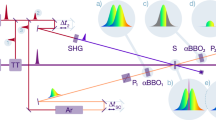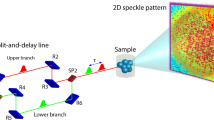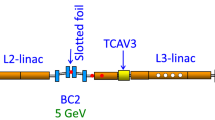Abstract
Recently, few-femtosecond pulses have become available at hard X-ray free-electron lasers. Coupled with the available sub-10 fs optical pulses, investigations into few-femtosecond dynamics are not far off. However, achieving sufficient synchronization between optical lasers and X-ray pulses continues to be challenging. We report a ‘measure-and-sort’ approach, which achieves sub-10 fs root-mean-squared (r.m.s.) error measurement at hard X-ray FELs, far beyond the 100–200 fs r.m.s. jitter limitations. This timing diagnostic, now routinely available at the Linac Coherent Light Source (LCLS), is based on ultrafast free-carrier generation in optically transparent materials. Correlation between two independent measurements enables unambiguous demonstration of ∼6 fs r.m.s. error in reporting the optical/X-ray delay, with single shot error suggesting the possibility of reaching few-femtosecond resolution.
This is a preview of subscription content, access via your institution
Access options
Subscribe to this journal
Receive 12 print issues and online access
$209.00 per year
only $17.42 per issue
Buy this article
- Purchase on Springer Link
- Instant access to full article PDF
Prices may be subject to local taxes which are calculated during checkout




Similar content being viewed by others
References
Zewail, A. H. Femtochemistry. Past, present, and future. Pure Appl. Chem. 72, 2219–2231 (2000).
Barty, A. et al. Ultrafast single-shot diffraction imaging of nanoscale dynamics. Nature Photon. 2, 415–419 (2008).
Emma, P. et al. First lasing and operation of an angstrom-wavelength free-electron laser. Nature Photon. 4, 641–647 (2010).
Glownia, J. M. et al. Time-resolved pump–probe experiments at the LCLS. Opt. Express 18, 17620–17630 (2010).
Bionta, M. R. et al. Spectral encoding of X-ray/optical relative delay. Opt. Express 19, 21855–21865 (2011).
Maltezopoulos, T. et al. Single-shot timing measurement of extreme-ultraviolet free-electron laser pulses. New J. Phys. 10, 033026 (2008).
Löhl, F. et al. Electron bunch timing with femtosecond precision in a superconducting free-electron laser. Phys. Rev. Lett. 104, 144801 (2010).
Meyer, M. et al. Two-color photoionization in XUV free-electron and visible laser fields. Phys. Rev. A 74, 011401(R) (2006).
Azima, A. et al. Time-resolved pump–probe experiments beyond the jitter limitations at FLASH. Appl. Phys. Lett. 94, 144102 (2009).
Fritz, D. M. et al. Ultrafast bond softening in bismuth: mapping a solid's interatomic potential with X-rays. Science 315, 633–636 (2007).
Tavella, F., Stojanovic, N., Geloni, G. & Gensch, M. Few-femtosecond timing at fourth-generation X-ray light sources. Nature Photon. 5, 162–165 (2011).
Righini, R. Ultrafast optical Kerr effect in liquids and solids. Science 262, 1386–1390 (1993).
Teubner, U., Wagner, U. & Förster, E. Sub-10 fs gating of optical pulses. J. Phys. B 34, 2993–3002 (2001).
Thaury, C. et al. Plasma mirrors for ultrahigh-intensity optics. Nature Phys. 3, 424–429 (2007).
Gahl, C. et al. A femtosecond X-ray/optical cross-correlator. Nature Photon. 2, 165–169 (2008).
Schorb, S. et al. X-ray optical cross-correlator for gas-phase experiments at the Linac Coherent Light Source free-electron laser. Appl. Phys. Lett. 100, 121107 (2012).
Beye, M. et al. X-ray pulse preserving single-shot optical cross-correlation method for improved experimental temporal resolution. Appl. Phys. Lett. 100, 121108 (2012).
Ziaja, B., London, R. A. & Hajdu, J. Unified model of secondary electron cascades in diamond. J. Appl. Phys. 97, 064905 (2005).
Krupin, O. et al. Temporal cross-correlation of X-ray free electron and optical lasers using soft X-ray pulse induced transient reflectivity. Opt. Express 20, 11396–11406 (2012).
Moeller, S. et al. Photon beamlines and diagnostics at LCLS. Nucl. Instrum. Methods 635, S6–S11 (2011).
Düsterer, S. et al. Femtosecond X-ray pulse length characterization at the Linac Coherent Light Source free-electron laser. New J. Phys. 13, 093024 (2011).
Sokolowski-Tinten, K. et al. Femtosecond X-ray measurement of coherent lattice vibrations near the Lindemann stability limit. Nature Phys. 422, 287–289 (2003).
Ziaja, B. & Medvedev, N. Modelling ultrafast transitions within laser-irradiated solids. High Ener. Dens. Phys. 8, 18–29 (2012).
Medvedev, N. & Rethfeld, B. Transient dynamics of the electronic subsystem of semiconductors irradiated with an ultrashort vacuum ultraviolet laser pulse. New J. Phys. 12, 073037 (2010).
Medvedev, N., Zastrau, U., Förster, E., Gericke, D. O. & Rethfeld, B. Short-time electron dynamics in aluminum excited by femtosecond extreme ultraviolet radiation. Phys. Rev. Lett. 107, 165003 (2011).
Medvedev, N. & Rethfeld, B. Electron kinetics in semiconductors and metals irradiated with VUV–XUV femtosecond laser pulses. Proc. SPIE 8077, 80770Q (2011).
Acknowledgements
The authors acknowledge important scientific input from H-J. Lee, B. Nagler and E. Galtier. The authors also thank DESY and LCLS technicians for their support. This research was carried out at LCLS at the SLAC National Accelerator Laboratory. LCLS is an Office of Science User Facility operated for the US Department of Energy Office of Science by Stanford University.
Author information
Authors and Affiliations
Contributions
M.H. and M.Ca. designed the research. R.C. proposed the addition of the spectral encoding timing tool. M.H., M.Ca., R.C., M.R.B., D.F., M.Ch., D.Z., D.M.F., S.T. and H.T.L. set up the experiment and performed data collection. M.Ca. performed data analysis. N.M. and B.Z. performed non-equilibrium Monte Carlo simulations. M.H. and M.Ca. wrote the paper, with extensive suggestions from R.C., M.R.B. and N.M. and contributions from all other authors.
Corresponding authors
Ethics declarations
Competing interests
The authors declare no competing financial interests.
Supplementary information
Supplementary information
Supplementary information (PDF 7763 kb)
Rights and permissions
About this article
Cite this article
Harmand, M., Coffee, R., Bionta, M. et al. Achieving few-femtosecond time-sorting at hard X-ray free-electron lasers. Nature Photon 7, 215–218 (2013). https://doi.org/10.1038/nphoton.2013.11
Received:
Accepted:
Published:
Issue Date:
DOI: https://doi.org/10.1038/nphoton.2013.11
This article is cited by
-
Single-shot X-ray absorption spectroscopy at X-ray free electron lasers
Scientific Reports (2023)
-
Ferricyanide photo-aquation pathway revealed by combined femtosecond Kβ main line and valence-to-core x-ray emission spectroscopy
Nature Communications (2023)
-
Attosecond coherent control of electronic wave packets in two-colour photoionization using a novel timing tool for seeded free-electron laser
Nature Photonics (2023)
-
Nonequilibrium band occupation and optical response of gold after ultrafast XUV excitation
Scientific Reports (2022)
-
Achievement and prospect of the PAL-XFEL
Journal of the Korean Physical Society (2022)



